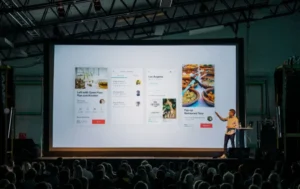At Megahertz Productions, we understand that running an event, whether corporate, hybrid, livestreamed or in-person—can be a significant investment. You’ve booked venue, equipment, production, marketing, maybe livestreaming and webcasting, audio-visual gear and support. But the question we hear repeatedly is: how do you know whether it was worth it? In other words: how do you measure event ROI (Return on Investment)?
In this article we’ll walk you through a clear, actionable framework to measure event ROI—from setting goals before the event begins, through capture of results afterward. While our specialty is AV rental, event production and livestreaming/webcasting services, the principles apply broadly to any event. Use this as a guide to turn your next event from a guess-work scenario into a data-driven investment.
Why Measuring Event ROI Matters
Measuring event ROI is not just a nice-to-have. It matters for several reasons:
- It helps you justify budget and resources by showing tangible outcomes.
- It enables you to optimize future events, by learning what worked and what didn’t.
- It supports stakeholder alignment, especially when multiple teams (marketing, sales, production) are involved.
- It ensures you treat the event as a business initiative, not just a one-off happening.
When we at Megahertz help with event production—including AV gear, livestreaming, staging and technical support—we treat our service as part of your investment. The better you track outcomes, the stronger your case for investment next time.
Step 1: Define Clear Event Objectives
Align objectives with organizational goals
Before the first cable is run or microphone tested, you need to ask: what is the event for? Are you launching a product, generating leads, strengthening brand awareness, training staff, or engaging remote audiences? The objective will drive how you measure success.
Make objectives SMART
Ensure your event objectives are Specific, Measurable, Achievable, Relevant, and Time-bound. For example: “Generate 120 qualified leads from our conference by end of day” is better than “get more leads”.
Determine the right metrics upfront
Once objectives are set, identify the metrics that will serve as proxies for success. Common examples include:
- Number of attendees (in-person + virtual)
- Number of qualified leads generated
- Conversion rate to product or service sign-up
- Engagement rate (e.g., session participation, Q&A interactions, chat messages)
- Brand uplift (survey results, social-media mentions)
- Cost per lead or cost per attendee
- Repeat attendance or retention for future events
By selecting these metrics before the event, you don’t end up scrambling after the fact.
Step 2: Calculate Total Event Cost
Break down direct costs
To know your ROI, you must understand your total cost. Consider:
- Venue rental
- AV rental and production services (including staging, lighting, sound, video)
- Livestreaming or webcasting services
- Marketing and promotion expenses
- Staff, travel, accommodation (if applicable)
- Post-event follow-up (video editing, content reuse)
- Miscellaneous (catering, décor, attendee swag)
Factor in opportunity cost
Don’t ignore what you might have done instead of this event: missed sales, internal resources diverted, etc. While harder to quantify, it can affect how you view ROI.
Establish cost baseline per objective
Say you’re targeting 200 qualified leads and your total cost is $40,000. That gives a cost baseline of $200 per lead before conversions, which sets the stage for assessing whether you hit a profitable threshold.
Step 3: Capture and Measure Performance Data
Track attendance and participation
Use registration tools, badge-scanning, QR-codes, virtual join metrics and livestream platform analytics to track how many attended and how engaged they were.
Monitor engagement analytics
For virtual or hybrid events your AV partner might provide live-stream access numbers, chat participation, polling responses, and drop-off rates. For in-person, measures like session attendance, audience interaction, and breakout participation matter.
Collect lead and conversion data
Link event registration to CRM systems and trace which attendees moved into qualified lead status or further down the funnel. If you offered product demos, webinars, or one-on-one sessions, track how many booked or converted.
Measure brand and communication outcomes
Surveys, Net Promoter Score (NPS), social-media mentions, post-event downloads of content, or replay views can all indicate how well your event resonated.
Step 4: Analyse ROI and Interpret Results
Basic ROI formula
A standard calculation is:
(Gain from event − Cost of event) ÷ Cost of event = ROI (in percentage)
“Gain” might mean revenue generated, value of leads, or future business estimated. Suppose your event generated $80,000 in sales attributable to the event and cost $40,000:
($80,000 − $40,000) ÷ $40,000 = 1.0 → 100 % ROI
Cost per key metric
Beyond overall ROI, compute cost per lead, cost per attendee, cost per conversion, etc. These allow better comparisons between events of different size or format.
Compare vs. benchmarks
If you ran a previous event with cost $30,000 and generated 150 leads, cost per lead was $200. If this time cost is $40,000 and you got 230 leads → cost per lead ≈ $174 → better efficiency. Determine whether your event improved over prior ones or industry benchmarks.
Qualitative insights
Some value isn’t immediately quantifiable. For example: brand awareness gained via social media exposure, high-quality content created during the event (videos, photos), new partnerships initiated, attendee satisfaction. While these may not appear in a pure ROI formula, they are real value.
Step 5: Leverage Post-Event Assets and Improve Future Events
Reuse content to extend value
If your event was livestreamed or web-cast, chances are you have recordings, highlight reels, and assets you can repurpose. By re-using that content (on your website, social media, email campaigns) you extend the ‘gain’ part of your ROI.
Follow up and nurture leads
An event should be part of a broader funnel. If attendees are not engaged post-event, the cost remains sunk. Execute targeted follow-up emails, access to on-demand sessions, surveys with feedback, and nurture sequences.
Survey for feedback and continuous improvement
Ask attendees for feedback: what worked, what didn’t, suggestions. This not only improves next time but also adds qualitative data to your ROI story.
Adjust your next event based on findings
Perhaps your livestream attendance was high but engagement low—so for next time you might use more interactive features (Q&A, polls, breakout rooms). Or maybe your AV costs were high — you might negotiate or change vendor. Use data and insights to optimise.
Practical Checklist: Measuring Event ROI for Your Next Event
- Define clear objectives (lead generation, brand awareness, revenue)
- Map metrics aligned with those objectives (attendance, engagement, conversions)
- Compute full event cost (venue + production + marketing + internal effort)
- Implement tracking tools for attendance, participation, lead capture
- Post-event: gather data (attendee numbers, leads, conversions, content reuse)
- Calculate ROI and cost per metric
- Document qualitative value (brand impact, content assets)
- Follow up leads, reuse assets, survey attendees
- Debrief with your team and vendors (including AV/production partner)
- Apply learnings to future events
How AV and Production Services Enhance Your Event ROI
As an AV rental and production company offering services such as those listed on our site (audio & PA systems, video rentals, lighting, staging, livestreaming/webcasting) we recognize that AV is more than just gear—it’s enablement. Here’s how proper AV and production support helps maximize ROI:
- Professional production means less risk: Technical glitches can damage your messaging, attendee satisfaction and brand reputation. With our end-to-end setup, we reduce those risks.
- Livestreaming/webcasting expands reach: Remote attendees boost your scale and give you additional data capture points (views, chats).
- High-quality recording & reuse: The content generated during the event becomes a marketing asset, adding incremental ROI beyond the live day.
- Engagement tools support interaction: Mic systems, audience reaction, lighting cues, video walls—these all keep attendees focussed, and higher engagement often leads to higher conversion.
- Scalable packages: Whether a board meeting or a large conference, tailored AV solutions help you avoid paying for unnecessary gear and thus lower cost-per-metric.
Common Pitfalls to Avoid When Measuring Event ROI
- Measuring only outputs, not outcomes: Counting attendees is good, but what matters is what they did afterward (converted, took action).
- Not tracking virtual/hybrid attendees properly: If you streamed or webcast, you may miss remote viewer data without proper tools.
- Ignoring content reuse value: Many treat the event as done when the day ends—and ignore the content generated.
- Skipping take-aways or improvement process: Without documenting what worked/what didn’t, you’ll repeat mistakes.
- Setting vague objectives: “We want more leads” isn’t enough. If you don’t define what counts as a lead, you can’t measure cost per lead or ROI effectively.
Final Thoughts
Measuring event ROI is about bridging the gap between investment and impact. By setting smart objectives, tracking the right metrics, running cost analyses, capturing data and re-using content, you turn what could be a one-off cost into a strategic asset.
At Megahertz Productions we believe that when you pair great production (audio, video, lighting, livestreaming) with strong measurement and follow-up, you don’t just host events—you create experiences that drive business value. Let’s partner together to make your next event not just memorable—but measurable.
For more on how our AV rental and production services support your event goals, explore our equipment rentals and production services and let’s get started.



